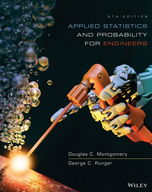Solution Found!
In the manufacture of electroluminescent lamps, several
Chapter 5, Problem 55E(choose chapter or problem)
Problem 55E
In the manufacture of electroluminescent lamps, several different layers of ink are deposited onto a plastic substrate. The thickness of these layers is critical if specifications regarding the final color and intensity of light are to be met. Let X and Y denote the thickness of two different layers of ink. It is known that X is normally distributed with a mean of 0.1 millimeter and a standard deviation of 0.00031 millimeter, and Y is normally distributed with a mean of 0.23 millimeter and a standard deviation of 0.00017 millimeter. The value of ◊◊for these variables is equal to 0. Specifications call for a lamp to have a thickness of the ink corresponding to X in the range of 0.099535 to 0.100465 millimeter and Y in the range of 0.22966 to 0.23034 millimeter. What is the probability that a randomly selected lamp will conform to specifications?
Questions & Answers
QUESTION:
Problem 55E
In the manufacture of electroluminescent lamps, several different layers of ink are deposited onto a plastic substrate. The thickness of these layers is critical if specifications regarding the final color and intensity of light are to be met. Let X and Y denote the thickness of two different layers of ink. It is known that X is normally distributed with a mean of 0.1 millimeter and a standard deviation of 0.00031 millimeter, and Y is normally distributed with a mean of 0.23 millimeter and a standard deviation of 0.00017 millimeter. The value of ◊◊for these variables is equal to 0. Specifications call for a lamp to have a thickness of the ink corresponding to X in the range of 0.099535 to 0.100465 millimeter and Y in the range of 0.22966 to 0.23034 millimeter. What is the probability that a randomly selected lamp will conform to specifications?
ANSWER:
Solution:
Step 1 of 4:
Let X and Y denote the thickness of two different layers of ink.
Here X is normally distributed with a mean of 0.1 millimeter and a standard deviation of 0.00031 millimeter.
And Y is normally distributed with a mean of 0.23 millimeter and a standard deviation
of 0.00017 millimeter.
The specification limit for a lamp to have a thickness of the ink corresponding to X in the range 0.099535 to 0.100465 millimeter, and Y in the range of 0.22966 to 0.23034 millimeter.
The correlation between these variables is zero.
We have to find the probability that a randomly selected lamp will conform to specification.
